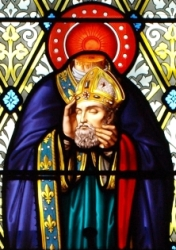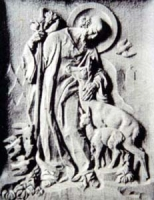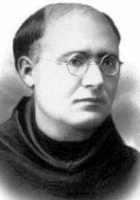Saint John Henry Newman
புனிதர் ஜான் ஹென்றி நியூமன்
கவிஞர்/ இறையியலாளர்/ கர்தினால்:
(Poet Theologian and Cardinal Deacon)
பிறப்பு: ஃபெப்ரவரி 21, 1801
லண்டன், இங்கிலாந்து, ஐக்கிய அரசுகள்
(London, England, United Kingdom)
இறப்பு: ஆகஸ்ட் 11, 1890 (வயது 89)
எட்க்பாஸ்டன், பிர்மிங்கம், இங்கிலாந்து, ஐக்கிய அரசுகள்
(Edgbaston, Birmingham, England, United Kingdom)
ஏற்கும் சமயம்:
ரோமன் கத்தோலிக்க திருச்சபை
(Roman Catholic Church)
இங்கிலாந்து திருச்சபை
(Church of England)
முக்திபேறு பட்டம்: செப்டம்பர் 19, 2010
திருத்தந்தை பதினாறாம் பெனடிக்ட்
(Pope Benedict XVI)
புனிதர் பட்டம்: அக்டோபர் 13, 2019
திருத்தந்தை ஃபிரான்சிஸ்
(Pope Francis)
முக்கிய திருத்தலம்:
பிர்மிங்கம் ஆலயம், எட்க்பாஸ்டன், இங்கிலாந்து
(Birmingham Oratory, Edgbaston, England)
பாதுகாவல்:
இங்கிலாந்து மற்றும் வேல்ஸ் (England and Wales) ஆகிய இடங்களிலுள்ள “வால்சிங்கம்” அன்னை துறவியர் குழுக்கள்
(Personal Ordinariate of Our Lady of Walsingham)
நினைவுத் திருநாள்: அக்டோபர் 9
புனிதர் ஜான் ஹென்றி நியூமன், ஆரம்ப காலத்தில் ஆங்கிலிக்கன் (Anglican) திருச்சபையின் ஒரு குரு ஆவார். சிறந்ததோர் கவிஞரும் இறையியலாளருமான இவர், பின்னாளில் கத்தோலிக்க திருச்சபையில் “கர்தினாலாக” (Cardinal) ஆனார். மிகவும் முக்கியமான, மற்றும் சர்ச்சைக்குள்ளான இவர் கி.பி. 183ம் ஆண்டுகளில் இங்கிலாந்து முழுவதும் புகழ் பெறத்துவங்கினார். இவரின் படைப்புகள் சுயவிளக்கம் அளிக்க முயலும் கத்தோலிக்க மறையின் வாத வல்லுர்களுக்கு பெரிதும் உதவுகின்றது.
இவர் லண்டனில், ஆங்கிலிக்கன் திருச்சபையைச் சேர்ந்த பெற்றோருக்கு 6 குழந்தைகளுள் மூத்தவராகப் பிறந்தார். ஆக்ஸ்போர்டில் இருந்த ட்ரினிட்டி கல்லூரியில் தன் 19வது வயதில் இளங்கலைப் பட்டத்தைப் பெற்ற இவர் கி.பி. 1825ம் ஆண்டு, ஆங்கிலிக்கன் சபையின் குருவாக திருநிலைப்படுத்தப்பட்டார். ஆங்கிலிக்கன் சபைக்குருவாகவும் மெர்டன் கல்லூரியில் ஆசிரியராகவும் பணியாற்றினார்.
இவர் கிறிஸ்தவ வரலாற்றினாலும், குறிப்பாக ஹிப்போவின் அகஸ்டீனின் சுயவரலாற்று நூலினாலும் தூண்டப்பட்ட இவர், ஆங்கிலிக்கன் திருச்சபை திருத்தூதர் வழிமரபு கோருவதன் செல்லத்தகு தன்மையினைக் குறித்து சந்தேகம் எழுப்பினார். ஆங்லிக்கன் திருச்சபையும், லூத்தரன் திருச்சபையும் செய்துகொண்ட உடன்படிக்கை இவரின் சந்தேகங்களுக்கு வலுசேர்த்தது.
காலப்போக்கில் கத்தோலிக்க திருச்சபையின் படிப்பினைகளாலும், நடவடிக்கைகளாலும் கவரப்பட்டு, கி.பி. 1845ம் ஆண்டு, அக்டோபர் மாதம், 9ம் நாள், கத்தோலிக்க மறையில் இணைந்தார். கி.பி. 1847ம் ஆண்டு, கத்தோலிக்கத் திருச்சபையின் குருவாக அருட்பொழிவு செய்விக்கப்பட்டார். கி.பி. 1851ம் ஆண்டு, அயர்லாந்து கத்தோலிக்க பல்கலைக்கழகத்தின் (Catholic University of Ireland) முதல் அதிபராக திருச்சபையால் நியமிக்கப்பட்டார். கி.பி. 1879ம் ஆண்டு, மே மாதம், 15ம் தேதி, திருத்தந்தை பதின்மூன்றாம் லியோவினால் கர்தினாலாக உயர்த்தப்பட்டார். 11 ஆண்டுகள் கர்தினாலாக பணியாற்றிய நியூமன், கி.பி. 1890ம் ஆண்டு, தமது 89 வயதில் காலமானார்.
1991ம் ஆண்டு, வணக்கத்திற்குரியவர் என அறிவிக்கப்பட்ட இவருக்கு, 2010ம் ஆண்டு, செப்டம்பர் மாதம், 19ம் நாளன்று, திருத்தந்தை பதினாறாம் பெனடிக்ட் முக்திபேறு பட்டம் அளித்தார்.
திருத்தந்தை ஃபிரான்சிஸ் அவர்கள், 2019ம் ஆண்டு, அக்டோபர் மாதம், 13ம் நாளன்று, இவரை புனிதர் நிலைக்கு உயர்த்தி அருட்பொழிவு செய்தார்.
Profile
Educated at Ealing and Trinity College, Oxford. Chosen a fellow of Oriel College. Ordained an Anglican priest in 1824. Curate of Saint Clement's, Oxford for two years. As he continued his studies he began to be influenced by Catholic writers. Vicar of Saint Mary's in 1828. Resigned his position in 1832. Helped found and guide the Tractarian Movement beginning in 1833. His writings grew more and more in sympathy with Catholicism, and he was forced to resign his position at Saint Mary's. He claimed that his philosophy was a via media (middle way) between Catholicism and Luthero-Calvinism, but he came to see that this idea was just a repetition of old heresies. In 1841 he lived in seclusion with friends at Littlemore, reading, studying, and praying. In 1845 he joined the Catholic Church.
Ordained in Rome, Italy in 1846. Joined the Oratorians. Returned to England in 1847 where he lived in Maryvale, Cheadle, Saint Ann's, Birminghan, and finally Edgbaston where he lived the bulk of his remaining 40 years. Founded the London Oratory. Influential writer on matters of theology, philosophy, and apologetics bringing hundreds into the Church; noted poet. Made an honorary fellow of Trinity College in 1878. Created cardinal in 1879 by Pope Leo XIII.
Born
21 February 1801 at London, England
Died
11 August 1890 at Edgbaston, Birmingham, West Midlands, England of pneumonia
Beatified
• Sunday 19 September 2010 by Pope Benedict XVI
• recognition celebrated at an outdoor Mass in Coventry, Diocese of Birmingham, England
Canonized
• 13 October 2019 by Pope Francis at Saint Peter's Basilica, Rome, Italy
• the miracle involved the healing of a pregnant American woman from an life-threatening condition hemorrhage and blood-clot
Saint Publia
Profile
Mother of one son, John, who became bishop of Antioch. Widow. Formed a group of local Christian women into an informal community. When Julian the Apostate came through the area in 362, he stopped to hear the community singing Psalms during their prayers. He took part of their translation to be a direct insult to him, and had Publia smacked around by his men. He planned to have the entire community executed for the perceived slight, but was killed in battle with Persia soon after, leaving Publia and her sisters to live and worship in peace.
Born
4th century in Antioch, Syria
Died
4th century in Antioch, Syria of natural causes
Saint Denis of Paris
Also known as
• Denis of France
• Dennis, Denys, Dionysius
Profile
Missionary to Paris, France. First Bishop of Paris. His success roused the ire of local pagans, and he was imprisoned by Roman governor. Martyred in the persecutions of Valerius with Saint Rusticus and Saint Eleutherius. Legends have grown up around his torture and death, including one that has his body carrying his severed head some distance from his execution site. Saint Genevieve built a basilica over his grave. His feast was added to the Roman Calendar in 1568 by Pope Saint Pius V, though it had been celebrated since 800. One of the Fourteen Holy Helpers.
Died
• beheaded c.258 at Montmarte (= mount of martyrs)
• his corpse was thrown in the River Seine, but recovered and buried later that night by his converts
• relics at the monastery of Saint Denis
Patronage
• against frenzy
• against headaches
• against hydrophobia or rabies
• against strife
• France
• Paris, France
• possessed people
Saint John Leonardi
புனித ஜான் லியோனார்டி, சபை நிறுவுனர்
நினைவுத்திருநாள் : அக்டோபர் 9
பிறப்பு : 1541, டஸ்கனி Tuscany, இத்தாலி
இறப்பு : 9 அக்டோபர் 1609, உரோம்
முத்திபேறுபட்டம்: 1861, திருத்தந்தை 9 ஆம் பயஸ்
புனிதர்பட்டம்: 1938, திருத்தந்தை 11 ஆம் பயஸ்
பாதுகாவல்: மருந்தகங்கள்
இவர் மருந்து தயாரித்து விற்கும் கலையை கற்றார். ஆனால் அப்பணியை செய்ய விருப்பமில்லாமல் இருந்தார். இவரின் மனம் குருவாக வேண்டுமென்று ஆசைக்கொண்டது. எனவே அப்பணியை விட்டுவிட்டு, 1572 ஆம் ஆண்டு குருவானார். பிறகு மறைப்பணியை ஆற்றினார். முக்கியமாக இவர் தானாகவே முன்வந்து சிறுவர்களுக்கு மறைக்கல்வி கற்றுக் கொடுத்தார். இவர் 1574 ஆம் ஆண்டில் இறையன்னையின் பெயரால், துறவற சபை ஒன்றை நிறுவினார். இதனால் பல இன்னல்களை மேற்கொண்டார். இடையூறுகளால் மிகவும் பாதிக்கப்பட்டார். இருப்பினும், திருமறையை பரப்புவதற்கென்று, மீண்டும் மறைப்பணியாளர்களின் குழு ஒன்றை ஏற்படுத்தினார். உரோம் நகரிலுள்ள "திருமுறைப் பரப்புதலின் பேராயம்" என்ற நிறுவனத்திற்கும் அடித்தளம் இட்டார்.
திருத்தந்தையர்கள் பலரின் முயற்சியால் இச்சபைகள் அனைத்தும், இன்று சிறப்பாக செயல்படுகின்றது. திருச்சபையில் உள்ள பல சபைகள் மீண்டும் தங்களின் ஒழுங்குமுறைப்படி செயல்பட, இவர் பரிவன்புடனும், முன்மதியுடனும் செயல்பட்டார். இவையனைத்தையும் நிறைவேற்றி வெற்றி பெற பல துன்பங்களையும் பொறுமையோடு ஏற்று, எளிமையாக வாழ்ந்தார். 1614 ஆம் ஆண்டு திருத்தந்தை 5 ஆம் பவுல் இச்சபைகள் முழுமையாக செயல்பட அதிகாரம் வழங்கினார்.
செபம்:
மூவொரு கடவுளே! மனிதனின் நோய்கலை குணமாக்கும் மருந்து தயாரிப்பவர்களை நீர் கண்ணோக்கியருளும். தங்களின் பணியில் கவனம் செலுத்தி, சிறப்பாக செயல்பட, உம் சக்தியை தந்தருள வேண்டுமென்று இறைவா உம்மை மன்றாடுகின்றோம்.
Also known as
• Giovanni Leonardi
• Jean Leonardi
Profile
Worked as a pharmacist's apprentice while studying for the priesthood. After ordination on 22 December 1572, he worked with prisoners and the sick. His example attracted some young laymen to assist him, most of whom became priests themselves. This group formed Clerks Regular of the Mother of God of Lucca, a congregation of diocesan priests which, for reasons having to do with the politics of the Reformation and an unfounded accusation that John wanted to form the group for his own personal aggrandizement, provoked great opposition. The Clerks were confirmed on 13 October 1595 by Pope Clement VIII, but John was exiled from Lucca for most of the rest of his life. John was assisted in his exile by Saint Philip Neri, who gave him his quarters - and his pet cat!
In 1579 he formed the Confraternity of Christian Doctrine, and published a compendium of Christian doctrine that remained in use until the 19th century. He died from a disease caught while tending plague victims. By the deliberate policy of the founder, the Clerks have never had more than 15 churches, and today form only a very small congregation. The arms of the order are azure, Our Lady Assumed into Heaven; and its badge and seal the monogram of the Mother of God in Greek characters.
Born
1541 at Diecimo, Lucca, Italy
Died
• 8 October 1609 at Rome, Italy of natural causes
• buried in Santa Maria in Portico
Canonized
17 April 1938 by Pope Pius XI
Saint Louis Bertrand
புனித_லூயிஸ்_பெர்ட்ரண்ட் (1526-1581)
அக்டோபர் 09
இவர் (#Louis_Bertrand) ஸ்பெயின் நாட்டில் உள்ள வாலன்சியா என்ற இடத்தில் பிறந்தவர். இவரது பெற்றோர் இறைபற்றில் சிறந்தவர்களாகவும் நல்லவர்களாகவும் விளங்கியதால் இவர் அவர்களைப் போன்று வாழத் தொடங்கினார்.
பின்னாளில் இவர் புனித தோமினிக் துறவற சபையில் சேர்ந்து துறவியானார். அங்கு இவர் சிலகாலம் நவதுறவிகளுக்குப் பொறுப்பாளராகவும் பயிற்சியாளராகவும் இருந்தார்.
இந்நிலையில் இவர் இறைவன் தன்னை தென் அமெரிக்க நாடுகளுக்கு நற்செய்தி அறிவிக்க அழைக்கிறார் என்பதை உணர்ந்தார். இதனால் இவர் துறவுமடத்தில் பயிற்சி அளிப்பதை விட்டுவிட்டு தென்னமெரிக்க நாடுகளுக்குச் சென்று நற்செய்தி அறிவிக்க தொடங்கினார்.
புதிய இடம், புரியாத மொழி... இவற்றுக்கு நடுவிலும் இவர் மக்களுக்குக் கடவுளுடைய வார்த்தையை எடுத்துரைத்து, அவர்களை கிறிஸ்துவின்மீது நம்பிக்கை கொள்ளச் செய்தார். இதனால் ஆயிரக்கணக்கான மக்கள் கிறிஸ்துவின்மீது நம்பிக்கை கொள்ளத் தொடங்கினார்கள்.
இவர் பணி செய்த இடங்களில் இவருக்கு எதிர்ப்பு வராமல் இல்லை. ஒருமுறை இவர் லீவார்ட் என்ற இடத்தில் கடவுளுடைய வார்த்தையை எடுத்துரைத்துக் கொண்டிருக்கும்போது, காரிப்ஸ் (Caribs) என்ற இனக்குழுவினர் இவருடைய உணவில் நஞ்சு கலந்து இவரைக் கொல்ல பார்த்தனர்; ஆனால் இவர் அந்த நஞ்சு கலந்த உணவின்மீது சிலுவை அடையாளம் வரைந்து உண்டதால், அவ்வுணவு இவருக்கு ஒன்றுமே செய்யவில்லை.
இதற்குப் பிறகு இவர் தன் சொந்த நாட்டிற்குத் திரும்பிச் சென்று, அங்கிருந்த ஒரு சில ஆர்வமிக்க நற்செய்தி பணியாளர்களை முன்பு தான் பணியாற்றி வந்த இடத்திற்கு அழைத்து வந்து, யாருக்கும் அஞ்சாமல் துணிவோடு நற்செய்திப் பணியாற்றினார். இதற்கும் நல்ல பலன் கிடைத்தது.
இப்படிக் கடவுளுடைய வார்த்தையை அறிவிப்பதில் மிகுந்த ஈடுபாட்டோடு செயல்பட்ட இவர் 1581 ஆம் ஆண்டு இறையடி சேர்ந்தார். இவர் அமெரிக்காவின் திருத்தூதர் என அழைக்கப்படுகிறார்.
Also known as
• Apostle of South America
• Lewis Bertrand
• Luis Beltran
Profile
Relative of Saint Vincent Ferrer. Deeply religious from childhood, Louis joined the Dominicans in 1544 at age 18. Ordained in 1547 at age 21. Noted preacher. Master of novices for 30 years. Worked with plague victims in 1557. Friend of Saint Teresa of Avila, and helped her reform her order. Missionary to Central and South America, and to the Caribbean; Louis expected to be martyred. He survived a poisoning attacks by local shamans, and reported to have converted 15,000. Prophet, miracle worker, and may have had the gift of tongues. After seven years of work, Louis returned to Spain to report on the bad actions of Spaniards in the region; he was re-assigned to preaching and training novices in Valencia.
Born
1 January 1526 at Valencia, Spain
Died
9 October 1581 of natural causes at Valencia, Spain
Canonized
12 April 1671 by Pope Clement X
Patronage
• Caribbean vicariates
• Colombia
• Dominican novices
Representation
• chalice surmounted by a serpent
• extinguishing a fire
• holding a chalice occupied by a serpent (represents the attempts to poison him)
• holding a cross
Saint Donnino of Città di Castello
Also known as
Donino
Profile
Late 6th-century layman hermit who assisted Church authorities, including Saint Florido and Saint Amanzio, re-bulid Città di Castello, Italy and revitalize the faith there following the Greek-Gothic war. Following the death of Saint Amanzio, Donnino retired to spend the rest of his days as a hermit near Rubbiano. He later moved to a hermitage in modern Villa San Donino to be closer to Città di Castello.
Died
• 9 October 610 at the Villa San Donino hermitage near Città di Castello, Umbria, Italy of natural causes
• relics enshrined in a church at Villa San Donino
• relics given canonical recognition in 1543
• relics given canonical recognition in 1791
• relics given canonical recognition in 1869
Patronage
• against epilepsy
• against rabid dog attacks
Representation
with a small dog
Abraham the Patriarch
Also known as
Abram
Profile
Old Testament patriarch. Married to Sarah. Founder of the Hebrew nation. Father of all believers in the true God. At God's command he moved from his native Chaldea to Canaan. Nomadic shepherd. Reported to have lived to age 175.
Born
at Ur, Chaldea as Abram
Died
c.1700 BC of natural causes
Representation
• bearded old man offering food to three angels
• bearded old man holding a blanket containing small people representing the souls of all believers saved since his first reaction to God
Saint Domninus
Also known as
Donnino
Profile
Soldier. Personal attendant to Roman emperor Maximian Herculeus in Milan, Italy. Convert. When the anti-Christian persecutions began, Domninus fled, was captured, and immediately executed. Martyr.
Born
Parma, Italy
Died
• beheaded on 9 October 299 on the Via Claudia at Borgo San Donnino near Parma, Italy
• relics enshrined in a silver urn under the altar of the cathedral of the diocese of Fidenza, Italy
Patronage
• Castelfranco Emilia, Italy
• Credera Rubbiano, Italy
• Dernice, Italy
• Fidenza, Italy, city of
• Fidenza, Italy, diocese of
• Montecchio Emilia, Italy
Blessed Gunther
Profile
Cousin of Saint Stephen of Hungary. After a worldly youth, he was brought to the faith by Saint Godehard of Hildesheim. Benedictine monk at Niederaltaich, Bavaria, Germany. Falling back on his old ways, he actually campaigned to be abbot of Gollingen, and won the position; he was a complete failure in the position. Learning from the experience, he resigned the position and lived his last 28 years as a hermit in the mountains of Sumava, modern Czech Republic.
Born
955
Died
1045 of natural causes
Saint Deusdedit of Montecassino
Also known as
Deodato, Diodato
Profile
Benedictine monk in the abbey of Monte Cassino, Italy. Abbot of Monte Cassino in 828. Noted for his generosity and almsgiving. Imprisoned by the Prince of Benevento, Italy, who tried to extort money from him but killed him in the process. Martyr.
Died
martyred 9 October 834 in Benevento, Italy of starvation and general abuse
Saint Andronicus of Antioch
Also known as
Andronicus of Egypt
Profile
Ninth-century layman in Antioch, Syria. Married to Saint Athanasia of Antioch. Silversmith and possibly a banker. Father of two. On the death of their children, Andronicus and Athanasia agreed to live separately as hermits in upper Egypt. Made multiple pilgrimages to Jerusalem.
Patronage
• silver workers
• silversmiths
Saint Gislenus
Also known as
• Apostle of Hainault
• Ghislain, Gislain, Gisleno, Gisileno, Guislain
Profile
Frankish hermit. Lived in a forest in Hainault, Belgium. His reputation for holiness attracted many disciples for whom he built and governed an abbey, now known as Saint-Ghislain, near Mons, Belgium. Spiritual teacher of Saint Waltrude, Saint Lambert, and Saint Valerius.
Died
c.680
Blessed Bernard of Rodez
Also known as
Bernard of Montsalvy
Profile
Augustinian monk as a young man. Spiritual student of Blessed Gausberto of Montsalvy. Monk at Montsalvy abbey. Chosen abbot in 1079, he served for over 30 years.
Born
1040 in Rodez, France
Died
• 1110 of natural causes
• buried at Montsalvy abbey, Clermont-Ferrand, France
• re-interred in a chapel of the abbey church in 1258
Saint Athanasia of Antioch
Profile
Ninth-century lay woman in Antioch, Syria. Married to Saint Andronicus of Antioch. Mother of two. On the death of their children, Andronicus and Athanasia agreed to live separately as hermits in upper Egypt. Made multiple pilgrimages to Jerusalem.
Saint Eleutherius and Saint Rusticus
Profile
Priest and deacon who were tortured and martyred with Saint Denis.
Died
beheaded c.258 at Montmarte (= mount of martyrs)
Saint Demetrius of Alexandria
Profile
Patriarch of Alexandria, Egypt in 188; he served for 43 years. Supported the catechetical school of Alexandria, appointing Origen as director of the school in 203; he later exiled Origen for being ordained without permission.
Died
231 of natural causes
Saint Sabinus of the Lavedan
Also known as
• Apostle of the Lavedan
• Savin of the Lavedan
Profile
Educated in Poitiers, France. Benedictine monk at Liguge. Evangelist to the Lavedan in Pyrenees in France. Hermit.
Born
Barcelona, Spain
Died
c.820
Blessed Aaron of Cracow
Profile
Monk at Cluny Abbey, France. Spiritual student of Saint Odilo of Cluny. First abbot of the Benedictine abbey at Tyniec, Poland. First archbishop of Cracow, Poland, ordained in 1046.
Died
15 May 1059 of natural causes
Saint Dorotheus of Alexandria
Profile
Confessor of the faith, abused by Arian heretics for remaining loyal to orthodox Christianity.
Died
373 in Alexander, Egypt of natural causes
Saint Goswin
Profile
Studied in Paris, France. Taught theology in Douai, France. Benedictine monk at Anchin Abbey in 1113. Abbot at Anchin c.1130.
Born
at Douai, France
Died
1165 of natural causes
Saint Alfanus of Salerno
Profile
Benedictine monk at Monte Cassino Abbey. Archbishop of Salerno, Italy. Assisted Pope Saint Gregory VII on his death-bed.
Died
1085
Saint Geminus
Profile
Monk at Sanpaterniano de Fano, Narni, Umbria, Italy. Claimed by both the Basilians and Benedictines.
Died
c.815
Patronage
San Gemini, Italy
Saint Valerius
Also known as
Bellère, Beriher
Profile
Spiritual student of Saint Gislenus in Belgium and France.
Died
c.680
Saint Lambert
Profile
Spiritual student of Saint Gislenus in Belgium and France.
Died
c.680
Martyrs of Laodicea
Profile
Three Christians martyred together in Laodicea, but no other information about them has survived but their names - Didymus, Diodorus and Diomedes.
Died
Laodicea, Syria
Nine Martyrs of Astoria
Also known as
Martyrs of Turon
Profile
A group of Brothers of the Christian Schools and a Passionist priest martyred in the persecutions during the Spanish Civil War. They are -
• Aniceto Adolfo
• Augusto Andrés
• Benito de Jesús
• Benjamín Julián
• Cirilo Bertrán
• Inocencio de la Immaculada
• Julián Alfredo
• Marciano José
• Victoriano Pío
Died
martyred on 9 October 1934 in Turón, Spain
Canonized
21 November 1999 by Pope John Paul II
Also celebrated but no entry yet
• Our Lady of Good Help
• Monks of Lecceto
• Emmanuela Teresa of Bavaria
• Hector Antonius Valdivielso Sáez
• Oda of Parey
• Robert of Mariënweerd





































